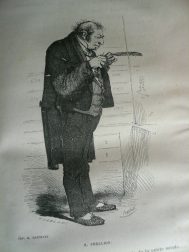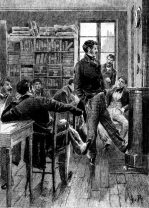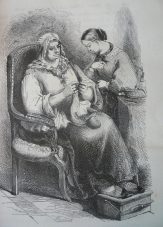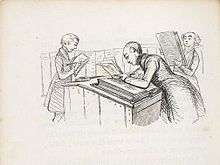
The Government Clerks
THE HUMAN COMEDY – Honoré de Balzac Eleventh volume of works of Honoré de Balzac edited by widow André Houssiaux, publisher, Hebert and Co, successors, 7 rue Perronet – Paris (1877) Scenes from Parisian life

Phellion employee
EMPLOYEES

Bidaut-Gigonnet employee
Dedication byHonoré-de-Balzac TO THE COUNTESS SERAFINA SAN-SEVERINO, NEE PORCIA Obliged d n order to avoid repeating anything, a few days ago I was leafing through the three hundred more or less droll tales in Il Bandello. Il Bandello, sixteenth-century writer, little known in France, and recently published in full in Florence in the compact edition of Italian Storytellers: your name, as well as that of the Count, struck my eyes as keenly as if it were yourself, Madame. I was browsing for the first time Il Bandello in the original text, and I found, not without surprise, that each tale, even if only five pages long, was dedicated in a familiar letter to the kings, queens and most illustrious people of the time, including the nobles of Milan, Piedmont, the homeland of Il BandelloFlorence and Genoa. It’s the Dolcini of Mantua, the San Severini of Crema, the Visconti in Milan, the Guidoboni from Tortonethe Sforza, visit Doriathe Frégose, visit Dante Alighieri (there was still one), the Frascator, Queen Marguerite of France, the Emperor of Germany, the King of Bohemia, Maximilian, Archduke of Austria, the Medici, visit SauliPallavicini, Bentivoglio of Bologna, SoderiniColonna, Scaliger, visit Cardone of Spain. In France: the Marignys, Anne de Polignac princesse de Marsillac and comtesse de La Rochefoucauld, the cardinal d’Armagnac, the bishop of Cahors, in short all the great company of the time, pleased and flattered by his correspondence with Boccaccio’s successor. I also saw how much Il Bandello had nobility of character: if he adorned his work with these illustrious names, he did not betray the cause of his private friendships. After the signora Gallerana, countess of Bergamo, comes the doctor to whom he dedicated his tale of Romeo and Juliet; after signora Molto magnifica Hypolita Visconti ed Ateliana, comes the simple captain of light cavalry Livio Liviano ; after the Duc d’Orléans, a preacher; after a Riario, comes messer magnifico Girolamo Ungaro, mercante lucchese, a virtuous man to whom he tells how a gentiluomo navarese sposa a che era sua sorella and figliuolano lo sapendo, sent to him by the Queen of Navarre. I thought I could, like Il Bandello put one of my stories under the protection of a a virtuosa, gentilissima, illustrissima comtessa Serafina San-Severina, and address him with truths that will be mistaken for flattery. Why not confess how proud I am to attest, here and elsewhere, that today, as in the sixteenth century, writers, whatever the level of fashion for a moment, are consoled from calumnies, insults and bitter criticism by beautiful and noble friendships whose suffrages help to overcome the troubles of literary life. Paris, that brain of the world, so pleased you with the continual agitation of its spirits; it was so well understood by the Venetian delicacy of your intelligence; you so loved Gérard’s rich salon that we have lost, and where, as in the work of Il Bandello the European illustrations of this quarter century; then the brilliant parties, the enchanted inaugurations of this great and dangerous syrene , have filled you with wonder You’ve been so naive in expressing your impressions that I’m sure you’ll take under your wing the painting of a world you may not have known, but which is not lacking in originality. I would have liked to have some beautiful poetry to offer you, who have as much poetry in your heart and soul as your person expresses; but if a poor prose writer can only give what he has, perhaps he will redeem in your eyes the modesty of the present by the respectful tributes of one of those deep and sincere admirations that you inspire. De Balzac.
Analysis of the work The works in this volume still belong to Scènes de la vie parisienne, but they were written at different times and correspond to different phases in Balzac’s career. The first of these, Les Employés, was serialized in La Presse in July 1837. Balzac’s life had been particularly hectic in the preceding months. The collapse of the Chronique de Paris had led to a number of complications for him. Balzac was being pursued by his creditors, and had to abandon his home in the rue Cassini and hide out in a garret in Chaillot, where he lived until October 1836. An advantageous treaty with two businessmen, Delloye and Lecou, gave him some respite, but the lawsuits resumed at the beginning of 1837: to escape his creditors, Balzac went on a three-month trip to Italy, from where he returned at the beginning of May 1837. As soon as he returned, the prosecution resumed. It was under these conditions that Balzac had to get back to work, and he announced to Madame Hanska a new urgent project, a novel entitled The Superior Woman which he hoped to write in four days, and from which his novel emerged, Employees. Balzac’s important novel has long baffled critics and historians alike. Its interest was only recently recognized, when Anne-Marie Meininger’s doctoral dissertation shed new light on the subject, demonstrating Balzac’s preoccupations with it. Despite this emphasis, the embarrassment of critics and historians is not without reason. There’s too much of a sense that Balzac has mixed two different objectives in this work, and even two subjects that he has failed to unite into a strongly organized whole. It is the history of the work itself that provides the secret of these hesitations, and reveals their dual significance.

Our employees
First of all, the title is surprising. The original title, La Femme supérieure, announces a “woman’s study”. The final title, The Employees, announces an “environmental study”. In principle, the two studies are one and the same. In fact, the two studies are superimposed, not linked, and Balzac sensed this perfectly. The story is indeed that of a “superior woman”, beautiful, intelligent, seductive, dreaming of a brilliant destiny that eludes her. The husband is a first-rate man, an important civil servant whose career has come to a standstill. Both struggle to get out of this rut, each by his own means: the wife by creating an environment that enhances her husband, the husband, who has the makings of a statesman, by preparing a project that leads to a complete overhaul of the administrative mechanism. They are about to triumph over each other. But they are victims of the pettiness and maneuvering of all those who swarm around an administrative unit and who can weigh on a minister and his cabinet. A twist of fate leads to their defeat: the administration will remain what it is, a spider’s web of employees, the husband, disgusted, resigns, “the superior woman” has lost the game. On the surface, it’s a single story. But the subject slipped: at the beginning, all the light is on “the superior woman”, it’s her life that’s being told, at the end all the light is on the employees, it’s a social milieu that’s being described. The subject of Les Employés has supplanted that of La Femme supérieure.  Balzac recognized this. He says as much, in a preface he later wrote for this book: “If the author,” he says, “abandons his original ideas for ones that arise after his primitive plan, he undoubtedly finds them more agreeable…the labor is less expensive, the character requires less fabric in his clothing, the colors of the description are less costly…If you find here many employees and few superior women, this fault is explicable for the above-mentioned reasons: the employees were ready, accommodated, finished, and the superior woman is yet to be painted. ” So what had happened? Balzac had good reason to take as his subject the impatience of a “superior woman” against the cumbersomeness and inertia of administrative machinery. He was looking at an irritating example. His sister Laure, whom he loved dearly and who was much admired in the family, had married a polytechnician with high expectations, who was vegetating in Bayeux as a civil servant in the Ponts-et-Chaussées department. Laure was bored in Bayeux, and her husband Surville was making no progress. But he was zealous. Three years after his marriage, in 1825, he had prepared a project for the Essonne canal, which he submitted to his administration. The project lay dormant in the Ministry’s files for four years, but was finally rejected. Balzac was so outraged by this refusal that he soon after, in 1833, began a tale that was never completed, Aventures constitutionnelles et administratives d’une idée heureuse et patriotique a first draft of his indictment. Surville left the administration and devoted himself to a new canal project, that of the lower Loire, which was no better received and a failure. These setbacks inspired further bitter reflections in Balzac’s Le Curé de village and his short story Z. Marcas. Laure was embittered by these disappointments, and spoke of her wasted life. She wanted to shine, to advise her husband, to be surrounded by the luxury and vanity that come with success. Her bitterness was sharp, and we pitied her. It’s quite possible that this situation inspired Balzac to depict a “superior woman” suffering from not being able to make her debut on the stage to which she believed she was destined. However, this only gave us one subject. There was a transposition to invent. Balzac’s “superior woman”, the brilliant Célestine Rabourdin, a rich girl – which Laure was not – lived in Paris, at a level of social life that Laure never approached, and was not deprived of the pleasures of vanity that Laure was frustrated with. We know nothing about this transposition, which may require an additional reference. But it was the subject itself which, as it developed, brought in elements foreign to this initial data. The confrontation of an intelligent woman with a social barrier, an anonymous enemy, may be a pathetic situation: but, to go beyond mere analysis, for there to be drama, there must be a struggle and, consequently, a stake and an adversary must be designated. The stakes are easy to find: it’s the promotion Rabourdin is aiming for. But the adversary has to be shown, described sufficiently to give us an idea of the unrecognized power that explains his success. In Balzac’s chosen subject, the employees can’t be the adversary: they’re simply components of a whole called the offices, which are not the agent, but the theater of the action. It’s not the employees who decide Rabourdin’s fate, but a maneuver mounted by forces outside the administration itself, priests, loan sharks, intriguers who show what the underground coalition of watchful rodents can do. Balzac calls them “termites”. He compares them to the small, invisible worms found in seawater, which bore into submerged wood, ship walls and dock pilings, and which, a hundred years earlier, had caused immense damage by destroying the dykes of Holland. In a way, the discovery of tarets marks a milestone in Balzac’s work. In his exploration of Paris, Balzac had indeed pointed out the caves and rat holes that Parisians pass by without noticing them: but these were simply manholes, the social drama played out above them, and they had no part in it. For the first time, they are actors, and even winners. Attentive, patient, they destroy: not to destroy, but because of the only feeling they know: greed. And this social subsoil that Balzac discovered, first in Paris, then in the provinces, Balzac would gradually bring to light in his next novels. Ursule Mirouêt, in Pierrette, in Le Cousin Pons, and even more so in Les Petits Bourgeois and Les Paysans. This invertebrate fauna, as typical as but far more active than that of the employees, is an important addition to Balzac’s social exploration and the keyboard of his dramatic mechanisms. The models were right in front of him. He had even reproduced them, but only as zoological specimens, in some of his short stories, in La Maison du chat qui pelote, in some passages of Ferragus orUne double famille, in some parts of César Birotteau, but without giving them a decisive role in the action. Balzac had known them well in the Marais district where he had spent his youth, among the shopkeepers of his maternal family: we see them appear from time to time in the family correspondence, light shadows passing in the background under the names of Malus, Vomorel, Dablin, about whom we know little and whom it is impossible, of course, to designate as originals of this or that character of the Employees.
Balzac recognized this. He says as much, in a preface he later wrote for this book: “If the author,” he says, “abandons his original ideas for ones that arise after his primitive plan, he undoubtedly finds them more agreeable…the labor is less expensive, the character requires less fabric in his clothing, the colors of the description are less costly…If you find here many employees and few superior women, this fault is explicable for the above-mentioned reasons: the employees were ready, accommodated, finished, and the superior woman is yet to be painted. ” So what had happened? Balzac had good reason to take as his subject the impatience of a “superior woman” against the cumbersomeness and inertia of administrative machinery. He was looking at an irritating example. His sister Laure, whom he loved dearly and who was much admired in the family, had married a polytechnician with high expectations, who was vegetating in Bayeux as a civil servant in the Ponts-et-Chaussées department. Laure was bored in Bayeux, and her husband Surville was making no progress. But he was zealous. Three years after his marriage, in 1825, he had prepared a project for the Essonne canal, which he submitted to his administration. The project lay dormant in the Ministry’s files for four years, but was finally rejected. Balzac was so outraged by this refusal that he soon after, in 1833, began a tale that was never completed, Aventures constitutionnelles et administratives d’une idée heureuse et patriotique a first draft of his indictment. Surville left the administration and devoted himself to a new canal project, that of the lower Loire, which was no better received and a failure. These setbacks inspired further bitter reflections in Balzac’s Le Curé de village and his short story Z. Marcas. Laure was embittered by these disappointments, and spoke of her wasted life. She wanted to shine, to advise her husband, to be surrounded by the luxury and vanity that come with success. Her bitterness was sharp, and we pitied her. It’s quite possible that this situation inspired Balzac to depict a “superior woman” suffering from not being able to make her debut on the stage to which she believed she was destined. However, this only gave us one subject. There was a transposition to invent. Balzac’s “superior woman”, the brilliant Célestine Rabourdin, a rich girl – which Laure was not – lived in Paris, at a level of social life that Laure never approached, and was not deprived of the pleasures of vanity that Laure was frustrated with. We know nothing about this transposition, which may require an additional reference. But it was the subject itself which, as it developed, brought in elements foreign to this initial data. The confrontation of an intelligent woman with a social barrier, an anonymous enemy, may be a pathetic situation: but, to go beyond mere analysis, for there to be drama, there must be a struggle and, consequently, a stake and an adversary must be designated. The stakes are easy to find: it’s the promotion Rabourdin is aiming for. But the adversary has to be shown, described sufficiently to give us an idea of the unrecognized power that explains his success. In Balzac’s chosen subject, the employees can’t be the adversary: they’re simply components of a whole called the offices, which are not the agent, but the theater of the action. It’s not the employees who decide Rabourdin’s fate, but a maneuver mounted by forces outside the administration itself, priests, loan sharks, intriguers who show what the underground coalition of watchful rodents can do. Balzac calls them “termites”. He compares them to the small, invisible worms found in seawater, which bore into submerged wood, ship walls and dock pilings, and which, a hundred years earlier, had caused immense damage by destroying the dykes of Holland. In a way, the discovery of tarets marks a milestone in Balzac’s work. In his exploration of Paris, Balzac had indeed pointed out the caves and rat holes that Parisians pass by without noticing them: but these were simply manholes, the social drama played out above them, and they had no part in it. For the first time, they are actors, and even winners. Attentive, patient, they destroy: not to destroy, but because of the only feeling they know: greed. And this social subsoil that Balzac discovered, first in Paris, then in the provinces, Balzac would gradually bring to light in his next novels. Ursule Mirouêt, in Pierrette, in Le Cousin Pons, and even more so in Les Petits Bourgeois and Les Paysans. This invertebrate fauna, as typical as but far more active than that of the employees, is an important addition to Balzac’s social exploration and the keyboard of his dramatic mechanisms. The models were right in front of him. He had even reproduced them, but only as zoological specimens, in some of his short stories, in La Maison du chat qui pelote, in some passages of Ferragus orUne double famille, in some parts of César Birotteau, but without giving them a decisive role in the action. Balzac had known them well in the Marais district where he had spent his youth, among the shopkeepers of his maternal family: we see them appear from time to time in the family correspondence, light shadows passing in the background under the names of Malus, Vomorel, Dablin, about whom we know little and whom it is impossible, of course, to designate as originals of this or that character of the Employees.

Madame Saillard and her daughter
This figuration has its place among the obstacles encountered by the “superior woman”: it doesn’t detract from the subject Balzac has set himself, on the contrary, it is an indispensable element of it. The same cannot be said of the collection of “employees” who will be paraded in good order after the novel’s exhibition has been set up, and whose parade will require so much space that the “superior woman” relegated to her salon, far from the theater of war, will be forgotten. This description of employees was no less important to Balzac than his discovery of termites. It was even more so because, in naming this menagerie, Balzac realized that he was realizing, in a particularly favorable and typical sector, the nomenclature of social species that he had set himself as the object of his first short stories, and which he was soon to claim as the common thread running through all his works. The Human Comedy. For no other of Balzac’s novels so clearly illustrates the principle Balzac posited in his famous Foreword by The Human Comedy in 1842: “There have always been, and always will be, Social Species, just as there are Zoological Species. If Buffon produced a magnificent work by attempting to represent the whole of zoology in one book, was there not a similar work to be done for society? Indeed, “employees” belong to a social “genre”, the petty bourgeoisie, and within this genre they clearly constitute a “species”. The “projection” was significant in this particular case. In the end, however, it is this exemplary meaning of Les Employés that will unbalance the whole novel, not only because of the space the description required, but also because of the additions Balzac felt it essential to enrich it with. For, if the version of La Femme supérieure, which appeared under this title in La Presse in 1837, had the disadvantage, for which Balzac himself apologizes, of sacrificing the main character to the description of a certain “milieu”, this imbalance was aggravated in the definitive version that we read today: it is the one that Balzac presented under the title Les Employés when he had his novel recomposed in 1842 for inclusion in the edition of The Human Comedy. Four years after the publication of La Femme supérieure, in 1841, a publishing house commissioned Balzac to write Physiologie de l’Employé . Balzac, who only sold his works for a limited period of time, was free to use the text of his novel. So he took a pair of scissors, cut out the entire section of La Femme Supérieure devoted to employees, added a few pages of introductory information on the administration, its quirks, its pomp and its works, and followed it all up with a few faces of employees who hadn’t been part of the initial figuration. For the amusement of readers, the zoological classification of employees was accentuated in this presentation, giving the reader the impression of visiting Noah’s Ark. The public loved this fantasy, and Balzac in particular, who found in it a highly expressive advertising application for his general idea of a natural history of society. When he took over The Superior Woman to include it in the The Human ComedyBalzac found his initial description of the employees quite succinct compared with the more complete picture he had given in his Physiology. So he picked up his scissors again and added The Superior Woman some of the new portraits and general considerations in his little essay. The description of the employees was enriched, but the imbalance between the two hemispheres of the novel was aggravated. Balzac then realized that the novel he had written was not the one he had intended. He’d had a hunch from the start: he wanted to add a fourth part to his novel, which seemed to him an incomplete history of the two people he’d wanted to interest his readers in. He gave up: it was too time-consuming a job. Balzac preferred a simple statement. In the The Human Comedyhe entitled this expanded version of his novel : Les Employés or La Femme supérieure. And finally, when he indicated on his copy of the Furne edition of The Human Comedy corrections to be made to a subsequent edition, he chose as his definitive title Employees and this is the title under which his novel has been known ever since.
The story The drama unfolds in the offices of a ministry where two department heads, Xavier Rabourdin and Ysidore Baudoyer, are vying for the post of head of division, the late Monsieur de la Billardière. Xavier Rabourdin feels he deserves this promotion on the grounds of seniority and merit. A capable man, Monsieur Rabourdin, supported by his wife, Célestine, has been working for several years in the deepest secrecy on a major administrative reform project. The latter consists of a staff overhaul designed to improve the public’s opinion of bureaucracy. By employing fewer staff, the Administration will be able to reward the best of them with promotions based on merit, pensions will be abolished and the Administration, by training its young employees, will be able to provide for their retention and advancement based on the skills of each individual. The second office manager, Monsieur Isidore Baudoyer, from the same ministry, was supported by the Church and a circle of scheming petit bourgeois. He is also spurred on by the ambition of his wife, Elisabeth. The battle is therefore between the two women, who each organize their own plan and unite their supporters into two distinct clans. Count des Lupeaulx, the minister’s secretary general, is assiduously courting Célestine Rabourdin, giving him a head start over his rival. But the tenacity of the Church and the petty bourgeois whose interests were at stake, set about ruining the reputation of the Rabourdin clan for the benefit of Baudoyer. A mistake made by Sébastien, Xavier Rabourdin’s young secretary, reveals the office manager’s secret work on his reform project. The latter was unanimously accused of being an “administrative executor”. This mistake was to prove fatal as it led to the outbreak of a scandal fuelled by the opposing camp and aimed at disgracing Rabourdin, who was forced to resign.

Registration supernumeraries
Source analysis/history: Preface compiled from the complete works of the Comédie Humaine (Tome XVII) published by France Loisirs 1985 under the auspices of the Société des Amis d’Honoré de Balzac.
Les Employés ou la Femme supérieure appeared in its original edition in 1838, under the title La Femme supérieure, in two volumes published by Werdet. In 1843, Balzac dedicated the book to David d’Angers (who made a medallion and sculpture of the author). The work finally appeared under a different title in 1844, published by Furne, in Scènes de la vie parisienne: Les Employés ou la Femme supérieure . The title was changed again in 1845 to Les Employés. In his great undertaking to reveal all aspects of the society in which he lived, Balzac here tackles a subject that may have seemed minor in his day, but which seems almost contemporary today. Office life, with its pettiness and intrigues to obtain a higher position, is the daily lot of the characters in the novel, most of whom are secondary figures in the story. The Human Comedy. Apart from cartoonist Jean-Jacques Bixiou, who also appears in La Rabouilleusethe comte des Lupeaulx, who plays an important role in the La Cousine Bette, La Maison Nucingen and Splendors and miseries of courtesans, and Célestine Rabourdin (also in La Cousine Bette)The protagonists are as petty as their stakes.
Additional source: Wikipedia.

Character used to represent Rabourdin
The characters Monsieur de laBillardière: Head of the two-office division who is dying and dies in the course of history. Xavier Rabourdin: An honest, capable man, he heads up one of the offices in the de la Billardière division. He initiated a project to reform the administration and applied for the vacant post at La Billardière. Rabourdin’s subordinates are : Fleury, a pro-Rabourdin, Sébastien, his loyal young secretary, Dutocq, whose deceit and greed will lead him to betray his boss to the opposing camp, the Baudoyer office; Poiret, on the eve of retirement, Phellion, Thuillier and Vimeux. Célestine Rabourdin: Loving wife of Sieur Rabourdin. His refusal of des Lupeaulx’s advances contributed to the latter’s vengeance at seeing Baudoyer take Rabourdin’s place. Isidore Baudoyer: Dumb and unqualified – Rabourdin’s rival for the La Billardière post. His subordinates are: Godard, du Bruel, who is aiming for the position of office manager if Baudoyer becomes division manager, Bixiou, who is also aiming for the position of office manager, Minard for promotion to senior clerk, Desroys, Colleville for promotion to sous-chef, Paulmier. Elisabeth Baudoyer: jealous rival of Célestine (who is a beautiful woman) and of her couple. Clément des Lupeaulx:General secretary to the minister and courtier to Célestine Rabourdin. Célestine’s scorned lover, he sets out to destroy her husband’s career out of vengeance and self-interest, and is the main instigator of this drama.
No Comments